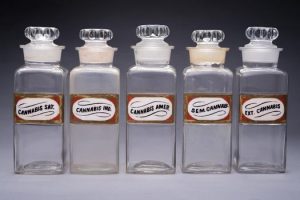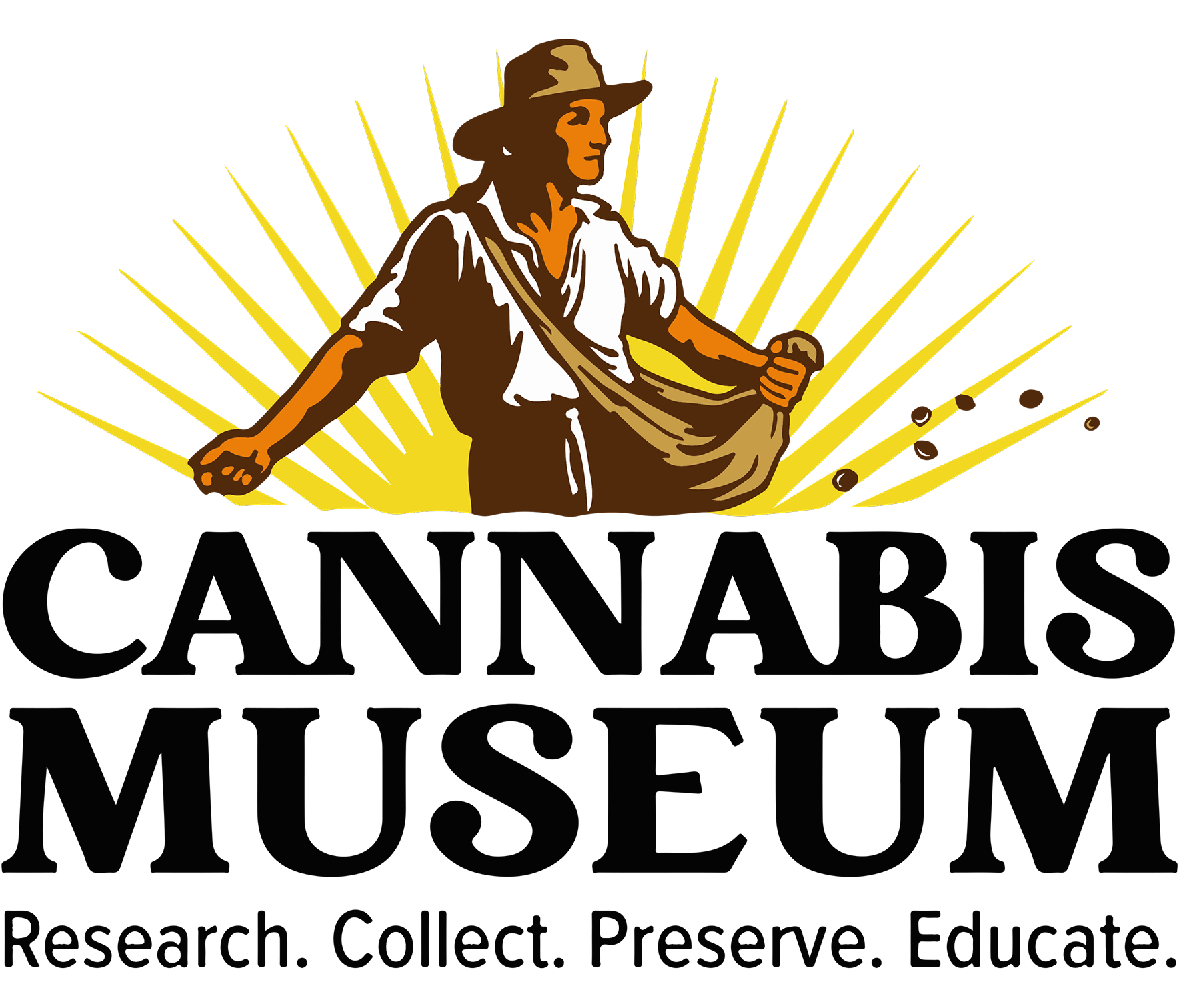Shelf Ware Set of Cannabis Apothecary Jars
 These five jars constitute a complete compounding Cannabis pharmacy typical of early twentieth century America. The set demonstrates the advanced knowledge that practitioners of that day possessed about Cannabis and its various forms and uses. This pharmacy carried all three known varieties of herbal Cannabis: Sativa, Indica and Americana, as well as hemp seeds and Cannabis extract. The extract was made by infusing flowering tops in alcohol and then distilling the alcohol out of the mixture. This left a thick, dark concentrate similar to the crude extracts that are becoming popular today for treating cancer and other diseases. The bottles were blown in a two-piece mold with diagonal seams. The stopper is a salt mouth hollow pattern with indentations made in a two-piece mold. These bottles have matching, hand-painted glass labels, edge banded in gold with a fine red outline. The recessed glass label process was patented in 1862 by Wm. N. Walton of New York City and soon became the most popular label style in the U.S., dominating shelf ware design for the next seventy years. At the time these bottles were manufactured, the average drugstore had scores of apothecary jars of drugs on display, often more than 150. As the technology for bottle making improved, apothecary jars became uniform and available in a wide range of capacities. The shelf bottles stayed on display and were refilled from bulk containers and liquid carboy bottles. Each bottle is 10″ tall by 3 1/2″ square, including stopper, with the bottoms embossed “F&S, St. Louis Mo. Patd March 6th 1894.” Fay and Schueler Co., St, Louis, MO. Left to Right: CANNABIS SAT., Cannabis sativa, herbal material providing predominantly cannabidiol (CBD). CANNABIS IND., Cannabis indica, herbal material providing predominantly tetrahydrocannabinol (THC). CANNABIS AMER., Cannabis americana, of mixed genetics providing a blend of CBD and THC. SEM. CANNABIS., Seeds of Cannabis. Hemp seed has been in continuous use for tens of thousands of years. Hemp seed is a protein, an oil and a mineral rich food source. The seeds were also used medicinally for a range of prescriptions, including laxatives, corn plasters and dyes. EXT. CANNAB., Cannabis Extract. Even in these days, an extract was a concentrated product with a high THC content.
These five jars constitute a complete compounding Cannabis pharmacy typical of early twentieth century America. The set demonstrates the advanced knowledge that practitioners of that day possessed about Cannabis and its various forms and uses. This pharmacy carried all three known varieties of herbal Cannabis: Sativa, Indica and Americana, as well as hemp seeds and Cannabis extract. The extract was made by infusing flowering tops in alcohol and then distilling the alcohol out of the mixture. This left a thick, dark concentrate similar to the crude extracts that are becoming popular today for treating cancer and other diseases. The bottles were blown in a two-piece mold with diagonal seams. The stopper is a salt mouth hollow pattern with indentations made in a two-piece mold. These bottles have matching, hand-painted glass labels, edge banded in gold with a fine red outline. The recessed glass label process was patented in 1862 by Wm. N. Walton of New York City and soon became the most popular label style in the U.S., dominating shelf ware design for the next seventy years. At the time these bottles were manufactured, the average drugstore had scores of apothecary jars of drugs on display, often more than 150. As the technology for bottle making improved, apothecary jars became uniform and available in a wide range of capacities. The shelf bottles stayed on display and were refilled from bulk containers and liquid carboy bottles. Each bottle is 10″ tall by 3 1/2″ square, including stopper, with the bottoms embossed “F&S, St. Louis Mo. Patd March 6th 1894.” Fay and Schueler Co., St, Louis, MO. Left to Right: CANNABIS SAT., Cannabis sativa, herbal material providing predominantly cannabidiol (CBD). CANNABIS IND., Cannabis indica, herbal material providing predominantly tetrahydrocannabinol (THC). CANNABIS AMER., Cannabis americana, of mixed genetics providing a blend of CBD and THC. SEM. CANNABIS., Seeds of Cannabis. Hemp seed has been in continuous use for tens of thousands of years. Hemp seed is a protein, an oil and a mineral rich food source. The seeds were also used medicinally for a range of prescriptions, including laxatives, corn plasters and dyes. EXT. CANNAB., Cannabis Extract. Even in these days, an extract was a concentrated product with a high THC content.
Purchase Print of Shelf Ware Set of Cannabis Apothecary Jars
12 x 18 Chroma print
20 x 30 Chroma print
12 x 18 Fine Art Print Only
Framed Print – 12 x 18 image in a 16 x 22 maple finish frame
Framed Print – 12 x 18 image in a 16 x 22 dark brown finish frame
12 x 18 Art Block – Natural
8 x 12 Art Block – Natural
Left to Right:
Turkish Hashish bottle, 7″ tall with a 2 1/4″ diameter, brown glass bottle marked W.T. & CO. A salt mouth pattern made by Whitall Tatum Company in Millville, NJ from 1868 until 1903, it has a mushroom pattern snug fitting top. The glass label is hand lettered with red top and bottom bands, an early safety warning.
Moroccan Hashish, 8 1/2″ tall with a 4 1/4″ diameter. This is a heavy and highly polished bottle with horizontal bands at the base and shoulder. The thin, wide lid with elegant top was cast in a three-piece mold.
Octagonal Hashish Humidor with a molded top that features a recess under the handle to place a small moistened sponge to humidify the contents. Both crude and pressed hashish, as well as other smoking herbs including tobaccos and Cannabis flower tops, were stored in accessible counter jars like these.
The rose tinted jar was cast in a three section mold. Hashish Jar, 3 1/4″ tall made in a two-piece mold. This bottle is from a home pharmacy chest.
The elegant beaded edged stopper was cast in a three-piece mold. Hashish, display bottle with white recessed label made by Whitall, Tatum & Company (W.T. & CO.) of Millville, NJ from 1868 to 1903.
The 12″ tall flint glass bottle was blown in a two-piece mold and has several casting blemishes on the shoulder and neck. Hashish, display bottle, 10″ tall show apothecary with matching swirled inverted acorn stopper, the shoulder and base are banded with a matching pattern.
The elegant rose cast is the result of selenium added to the glass. Hashish, 7 1/4″ tall bottle with a 2 3/4″ diameter purple glass, the result of added magnesium. The bottle has a tall applied neck that was left unfinished. The copper leaf label is hand lettered and outlined in asphaltum. The inner lip of the cast stopper is embossed “EDDY & EDDY MFG. CO.,” marking an early twentieth century St. Louis glass manufacturer.
Hashish, large, 12″ x 4 1/8″ square counter bottle blown in a three section mold. The hollow and indented stopper comes from a two-piece mold. The bottom is embossed “F&S, St. Louis Mo. Pat’d March 6th 1894.” Fay and Schueler Co., St. Louis, MO.
Hasheesh, brown bottle made in the late nineteenth century by Whitall Tatum Company (W.T. & CO.) of Millville, NJ. Blown in a two-piece mold with side seams, the 8″ tall by 2 3/4″ square has a salt neck.
Hasheesh, thin flint glass bottle, 5 1/2″ tall, blown in a one-piece wooden mold. The solid stopper made in a two-piece mold has an unfinished pontil scar. This label is an excellent example of a surface applied glass label patented in England on June 19, 1854 by W.J. Bisseker.
